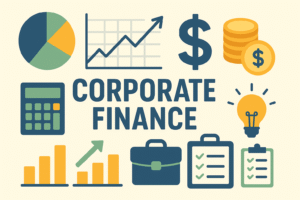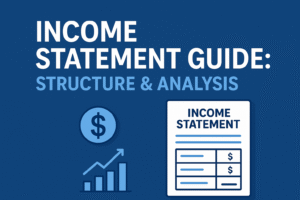Accounting is the language of business, and for that language to be understood globally, it needs consistency and structure. In the United States, this consistency is achieved through Generally Accepted Accounting Principles (GAAP). GAAP is a standardized framework of accounting rules, principles, and procedures designed to ensure financial reporting is transparent, consistent, and comparable across organizations.
Whether you are a business owner, investor, financial analyst, or tax professional, GAAP plays a critical role in how you interpret financial data. It establishes the foundation for preparing financial statements such as balance sheets, income statements, and cash flow reports.
Understanding GAAP
GAAP is not a single set of laws but rather a collection of authoritative standards and common industry practices. It is developed and maintained by the Financial Accounting Standards Board (FASB), which issues accounting rules in the form of Accounting Standards Codification (ASC).
The main purpose of GAAP is to create a uniform accounting system that minimizes misrepresentation and enhances comparability between companies. Without GAAP, businesses might use inconsistent methods, making it nearly impossible for stakeholders to analyze performance.
Some key principles that guide GAAP include:
- Principle of Regularity – adherence to established rules and standards.
- Principle of Consistency – using the same accounting methods from one period to another.
- Principle of Sincerity – providing accurate and unbiased financial information.
- Principle of Prudence – avoiding speculation and ensuring conservative reporting.
- Principle of Continuity – assuming that the business will continue operating indefinitely.
- Principle of Materiality – disclosing all information that could influence decision-making.
Together, these principles ensure that financial statements are not only accurate but also reliable for decision-making.
Compliance With GAAP
For many businesses, compliance with GAAP is not optional. Publicly traded companies in the U.S. are required by the Securities and Exchange Commission (SEC) to follow GAAP when preparing financial reports. This ensures transparency for investors, regulators, and the public.
Private companies, while not legally required to use GAAP, often adopt it for several reasons:
- To maintain credibility with lenders, investors, and stakeholders.
- To make future transitions to public markets smoother.
- To ensure internal financial data is consistent and reliable.
Compliance is achieved by following FASB-issued standards, staying updated with amendments, and ensuring accounting staff and auditors are properly trained in GAAP practices. Failure to comply can result in financial misstatements, regulatory penalties, or loss of investor trust.
GAAP vs. IFRS
While GAAP is used in the United States, many countries around the world follow the International Financial Reporting Standards (IFRS). Both systems share the goal of providing consistent, transparent, and comparable financial information, but they differ in methodology and application.
Key differences between GAAP and IFRS include:
- Approach – GAAP is rules-based, while IFRS is principles-based, giving companies more flexibility in interpretation.
- Inventory Accounting – GAAP allows both FIFO (First In, First Out) and LIFO (Last In, First Out), while IFRS prohibits LIFO.
- Revaluation of Assets – Under IFRS, companies can revalue assets to fair market value, but GAAP typically restricts this practice.
- Research & Development Costs – GAAP requires immediate expensing, while IFRS allows capitalization under certain conditions.
- Financial Statement Formats – Presentation requirements differ, with IFRS generally providing broader guidelines compared to GAAP’s structured rules.
As globalization continues, many argue for convergence between GAAP and IFRS to create a single set of universal accounting standards. While progress has been made, differences remain, and U.S. companies continue to report under GAAP.
Where Are Generally Accepted Accounting Principles (GAAP) Used?
GAAP is primarily used in the United States, and its influence extends across various industries and sectors. Its application includes:
- Public Companies – Mandated by the SEC for investor protection and transparency.
- Private Companies – Adopted voluntarily to maintain credibility with banks, investors, and stakeholders.
- Government Agencies – Used in certain forms of financial reporting for accountability.
- Nonprofit Organizations – Apply GAAP standards to ensure proper stewardship of funds and donor trust.
- Educational Institutions – Business schools and accounting programs teach GAAP as a foundation for accounting education.
Essentially, any organization that prepares financial statements in the U.S. will likely use GAAP, whether by law or best practice.
Why Is GAAP Important?
The importance of GAAP goes beyond regulatory compliance. It provides a foundation of trust in financial markets. Some of the main reasons GAAP is important include:
- Consistency – Financial statements prepared under GAAP can be compared across different periods and organizations.
- Transparency – Stakeholders can make informed decisions because GAAP minimizes hidden or manipulated reporting.
- Investor Confidence – Investors are more likely to fund businesses when financial data follows recognized standards.
- Legal Protection – Adhering to GAAP reduces the risk of fraud allegations and regulatory scrutiny.
- Internal Management – Businesses rely on GAAP-compliant reports for budgeting, forecasting, and performance tracking.
Without GAAP, the credibility of financial reporting would be significantly compromised, potentially leading to market instability.
What Are Non-GAAP Measures?
While GAAP provides a standardized structure, many companies also report Non-GAAP measures to highlight financial performance from a different perspective. Non-GAAP measures exclude certain items, such as restructuring costs, acquisitions, or non-cash expenses, to present what management believes is a clearer picture of “core” operations.
Some common Non-GAAP measures include:
- EBITDA (Earnings Before Interest, Taxes, Depreciation, and Amortization).
- Adjusted Earnings – Net income excluding unusual or one-time charges.
- Free Cash Flow – Cash generated after capital expenditures, not explicitly defined under GAAP.
While these measures can provide valuable insights, they can also be misleading if not reconciled to GAAP figures. The SEC requires public companies to provide a reconciliation of Non-GAAP metrics with their closest GAAP equivalents to prevent misuse.
Investors and analysts often look at both GAAP and Non-GAAP numbers to get a comprehensive view of a company’s financial health.
Real-World Examples of GAAP in Action
Understanding GAAP is easier when you see how it applies in real business scenarios. Many well-known companies in the U.S. report both GAAP and Non-GAAP results, which often gives investors two different perspectives on financial performance.
Example 1: Technology Companies (Apple, Microsoft, Google)
Tech giants like Apple and Google (Alphabet) follow GAAP when reporting earnings, but they also release Non-GAAP figures to show their “core” business performance.
- Under GAAP, Apple must report all expenses, including stock-based compensation and restructuring costs.
- Under Non-GAAP, Apple may exclude these costs, arguing that they distort the ongoing profitability of the business.
This means an investor might see Apple’s GAAP net income of, say, $20 billion, but its Non-GAAP adjusted income reported as $23 billion, depending on the excluded items. Both numbers are accurate, but they serve different purposes: GAAP ensures compliance, while Non-GAAP provides additional insights.
Example 2: Retail Industry (Walmart)
A company like Walmart applies GAAP principles to maintain consistency in its vast global operations. GAAP requires Walmart to follow standardized inventory accounting methods such as FIFO (First In, First Out) or LIFO (Last In, First Out).
- Walmart historically used LIFO for certain inventory categories, which is allowed under GAAP in the U.S. but prohibited under IFRS.
- This choice directly affects the cost of goods sold (COGS) and net income reported. During times of rising prices, LIFO results in higher COGS and lower taxable income.
This example shows how GAAP not only influences reporting but also has tax implications.
Example 3: Airlines (Delta, American Airlines)
Airlines often report significant one-time costs like fleet restructuring or fuel hedging losses.
- Under GAAP, these costs must be included in net income, which might show a sharp drop in profitability.
- Under Non-GAAP reporting, airlines may exclude these unusual charges to show investors that their “core” passenger operations are still profitable.
For example, Delta might report a GAAP net income of $500 million but highlight a Non-GAAP adjusted income of $1.1 billion after excluding restructuring costs.
Why These Examples Matter
These real-world cases highlight the importance of GAAP as a baseline standard. Regardless of industry, GAAP ensures that every company follows the same fundamental rules. Investors, analysts, and regulators can then compare companies on equal footing. Non-GAAP measures, while useful, are always secondary to GAAP and must be carefully reconciled to avoid misleading interpretations.
Final Thoughts
Generally Accepted Accounting Principles (GAAP) form the backbone of financial reporting in the United States. They ensure accuracy, comparability, and transparency, creating trust among businesses, investors, and regulators. While Non-GAAP measures and global standards like IFRS also play significant roles, GAAP remains the cornerstone of U.S. accounting practices.
As businesses grow and globalization increases, understanding GAAP is essential not only for accountants but also for anyone involved in financial decision-making.







